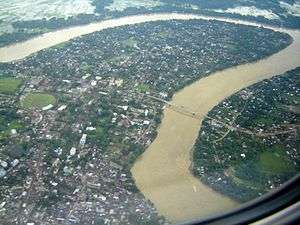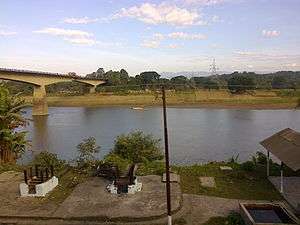Barak River
The Barak River is a 900-kilometre-long (560 mi)[1][2] river flowing through the states of Manipur, Nagaland, Mizoram and Assam in India and into the Bay of Bengal via Bangladesh. Of the 900 km, 524 km is in India, 31 km on Indo – Bangladesh border and the rest is in Bangladesh. The navigable portion of Barak River in India, the 121 km stretch between Lakhipur and Bhanga has been declared as National Waterway 6, (NW-6) in the year 2016.[3][4] The river drains an area of 52,000 km2 (20,000 sq mi),[1] of which 41,723 km2 (16,109 sq mi) lies in India which is nearly 1.38% of the total geographical area of the country.[5] The environment of Barak's basin hosts a wide variety of flora and fauna.
| Barak River | |
|---|---|
 | |
| Location | |
| Country | India and Bangladesh |
| Physical characteristics | |
| Source | |
| • location | Liyai Kullen Village |
| Mouth | |
• location | Bay of Bengal |
| Length | 900 km (560 mi) |
| Basin size | 52,000 km2 (20,000 sq mi) |
The principal tributaries of the Barak are all in India and are the River Sonai (Tuirial River), the Jiri, the Tlawng (Dhaleswari / Katakal), the Longai and the Madhura. Tipaimukh Dam is a proposed embankment dam on the Barak River.[6]
Sources
From its source at Liyai Kullen Village in Manipur state of India wherein the majority of the local population belongs to the Poumai Naga tribe, the river is known as Vourei. Near its source, the river receives a lot of streams, including the Vehrei originating from Phuba Village, Gumti, Howrah, Kagni, Senai Buri, Hari Mangal, Kakrai, Kurulia, Balujhuri, Shonaichhari and Durduria. It flows west in Manipur State, and borders Nagaland, then southwest to Assam where it leaves India and enters Bangladesh at Bhanga Bazar.

In the state of Manipur, it flows south-west to Tipaimukh where it is joined by the Tuivai river, and then flows northward to Jirimukh where it is joined by the Jiri river from the north. From Jirimukh, the river flows westward into Cachar, then Karimganj district of Assam, then to Sylhet in Bangladesh as the Surma river, and becomes the Meghna river before the Ganga-Brahmaputra river system. The Padma River joins it and flows into the Bay of Bengal as the Meghna river.
Wildlife
Barak is among the richest rivers in the world in terms of aquatic biodiversity, as it contains more than 2,000 species of fishes. Other creatures include River Barak crocodile, or Siamese crocodile (a rare and endangered crocodilian), susu dolphin, smooth-coated otter and the black mugger. From its origin, down to its bifurcation at the border of Nagaland into Surma River and Barak River, the Barak River is 564 kilometres (350 mi) long.[7] The biomes are extremely rich in wildlife and also very diverse in the entire stretch of the river including: 1. Varzea forest (flooded rainforest) 2. Los llamjao (flooded grassland and Savannah) 3. Tidal forest (mangroves in vast Delta Avourei) 4. Flora or vegetation of the Pats (flat-topped table mountains in India and western Cambodia) 5. Huge tropical swamps.
Environmental concerns
Environmentalists have expressed concern over the way aquatic creatures and their habitats are being destroyed in the upper reaches of river Barak in southern Assam. Prominent nature conservation NGO Society for Activists for Forest and Environment (SAFE) has pointed out that the tribals living on both banks of Barak have developed the harmful practice of blasting small gelatin sticks smuggled from Mizoram in the river to catch fish. In the process, thousands of fish both young and matured along with turtles, dolphins and other aquatic life organisms were becoming the victim of merciless killing.[8]
The Ganges river dolphin also face an imminent threat. The proposed Tipaimukh Dam on the Barak River in northeast India – a controversial political issue between India and Bangladesh – could be the last nail in the coffin for the elusive Ganges river dolphin in Assam’s Barak river system, researchers warn.[9] Making a plea for conservation, researchers from Assam have warned in a study that the endangered Ganges river dolphin, India’s national aquatic animal is heading towards “local extinction” in the Barak river system of the state. “Factors like poaching (for oil and meat) and accidental mortalities in fishing gears, gradual habitat degradation by sluice gates, embankments, disturbances like motorboats and aquatic pollution have resulted in the extirpation of the resident dolphin population from the Barak river system of Assam,” M.K. Mazumder, corresponding author of the study, told Mongabay-India.[9]
References
- "Rivers". asmenvis.nic.in. Retrieved 25 August 2019.
- "Surma River | river, Asia". Encyclopedia Britannica. Retrieved 25 August 2019.
- "Rajya Sabha passes Bill to declare Assam river as National Waterway". The Economic Times. 14 August 2013. Retrieved 25 August 2019.
- "National Waterways 16 | Inland Waterways Authority of India, Government of India". iwai.npglobal.in. Retrieved 25 August 2019.
- "Barak River System | Water Resources | Government Of Assam, India". waterresources.assam.gov.in. Retrieved 25 August 2019.
- "Tipaimukh Dam Controversy". GKToday. Retrieved 20 December 2019.
- "Barak and others". nrsc.gov.in. Water Resources Information System of India. 27 October 2015. Archived from the original on 4 April 2019. Retrieved 11 November 2017.
- "Concern over destruction of aquatic creatures in river Barak in Assam". The Economic Times. 3 February 2013. Retrieved 25 August 2019.
- "Is the Endgame Inevitable for the Ganges River Dolphin in Assam's Barak River?". The Wire. Retrieved 25 August 2019.
External links
- "Barak Basin". National Institute of Hydrology, Roorkee, India. Archived from the original on 15 May 2017.